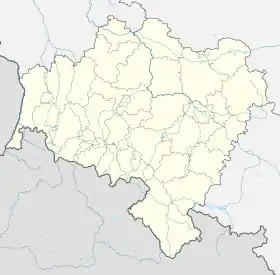Gorzanów | |
|---|---|
Village | |
 Saint Mary Magdalene Church | |
 Gorzanów  Gorzanów | |
| Coordinates: 50°21′07″N 16°37′56″E / 50.35194°N 16.63222°E | |
| Country | |
| Voivodeship | Lower Silesian |
| County | Kłodzko |
| Gmina | Bystrzyca Kłodzka |
| Population | |
| • Total | 921 |
| Time zone | UTC+1 (CET) |
| • Summer (DST) | UTC+2 (CEST) |
Gorzanów [ɡɔˈʐanuf] is a village in the administrative district of Gmina Bystrzyca Kłodzka, within Kłodzko County, Lower Silesian Voivodeship, in south-western Poland.[1] There is a large Gorzanów Castle in the village.
It lies approximately 6 kilometres (4 mi) north of Bystrzyca Kłodzka, 10 kilometres (6 mi) south of Kłodzko, and 91 kilometres (57 mi) south of the regional capital Wrocław.
Name and history

The earliest name of the locality seems to have been the German appellation Arnoldsdorf (or Arnsdorf), derived from the personal name Arnold (+dorf), probably the name of the Lokator who brought German farmers to the village.[2] The later German name of Grafenort derives from the noble title Graf (+ort, "locality"). In the seventeenth century the owner of the village was Johann Gundacker Graf von Heberstein. The name "Gorzanów" was introduced officially only after 1945.[3] The name "Gorzanów" appears in the standard gazetteer of Polish place-names, the Słownik geograficzny Królestwa Polskiego (vol. 7, p. 239, col. 1), only with reference to a Polish village in the Podolia, a different geographical region. The village discussed in the present article is listed under the name Grafenort (Słownik geograficzny, vol. 2, p. 791, col. 1), without a corresponding Polish toponymic.
The history of the village dates back to the 12th century, when a defensive stronghold existed at the site.[4] In the Middle Ages at various times it was part of Poland or Kingdom of Bohemia. Probably in the 14th century a royal castle was built, which was destroyed in 1470, and the remains were dismantled around 1804.[4] It was annexed by Prussia in the 18th century and from 1871 to 1945 it was also part of Germany.
The Słownik geograficzny Królestwa Polskiego states that, historically, theatrical performances were staged at "the beautiful castle of the Hebersteins" three times a week for eight months of the year, and that the place was known for its "steam baths". The village had a Catholic church, and a chapel dedicated to St. Anthony surmounting a hill of the same name, which rises to the height of 1,053 feet above sea level. The location is described as "utterly exquisite" (prześliczne położenie).[5]
During the Second World War the Nazis established a concentration camp on the premises of the palace,[6] a satellite camp of Gross-Rosen concentration camp.
A present-day guidebook describes the "palace of Gorzanów" as being in a complete state of dilapidation, unfit to accommodate sightseers.[7]
Gallery
 Castle
Castle Culture centre
Culture centre Statue of Saint John of Nepomuk
Statue of Saint John of Nepomuk Saint Barbara chapel
Saint Barbara chapel
References
- ↑ "Central Statistical Office (GUS) - TERYT (National Register of Territorial Land Apportionment Journal)" (in Polish). 2008-06-01.
- ↑ Kleine Kulturgeschichte der schlesischen Schlösser (in German). Vol. 1. Bergstadtverag Wilhelm Gottlieb Korn. 2015. p. 84.
- ↑ Nazwy miejscowe Polski: historia, pochodzenie, zmiany, ed. K. Rymut, vol. 3 (E–I, ed. Urszula Bijak, et al.), Cracow, Wydawnictwo IJP PAN (Institute of the Polish Language of the Polish Academy of Sciences), 1999, p. 251. ISBN 838557929X, ISBN 978-83-87795-45-0.
- 1 2 Waldemar Brygier, Tomasz Dudziak, et al., Ziemia Kłodzka: przewodnik dla prawdziwego turysty, Piastów, Oficyna Wydawnicza Rewasz, 2010, p. 328. ISBN 9788389188953.
- ↑ Słownik geograficzny Królestwa Polskiego, vol. 2, p. 791, col. 1.
- ↑ Waldemar Brygier, Tomasz Dudziak, et al., Ziemia Kłodzka: przewodnik dla prawdziwego turysty, Piastów, Oficyna Wydawnicza Rewasz, 2010, p. 329. ISBN 9788389188953.
- ↑ Waldemar Brygier, Tomasz Dudziak, et al., Ziemia Kłodzka: przewodnik dla prawdziwego turysty, Piastów, Oficyna Wydawnicza Rewasz, 2010, p. 219. ISBN 9788389188953.
